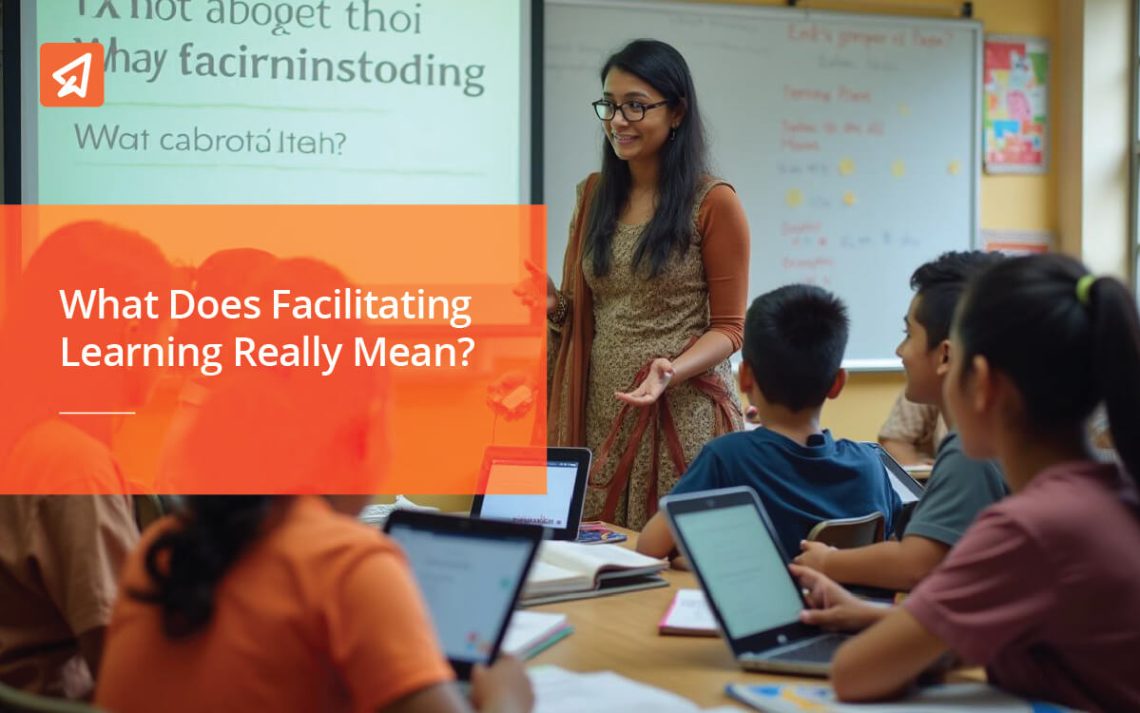What Does Facilitating Learning Really Mean?

As teachers, we often hear the term “facilitating learning,” but what does it actually mean in a practical sense? At its simplest, facilitating learning is about guiding students as they explore and understand new ideas, rather than just giving them the answers. It’s about creating an environment where students feel comfortable asking questions, making mistakes, and finding their own solutions. Instead of being the sole source of knowledge, you become a guide who helps students develop the skills they need to think critically and learn independently. In this article, we’ll explore what facilitating learning looks like in the classroom, how it can help students take more ownership of their education, and the ways it can improve the learning experience for everyone involved.
What is Facilitating Learning?
Facilitating learning is different from the traditional approach to teaching. In a typical classroom, the teacher is usually the one who shares information, and students are expected to remember and apply that knowledge in their work. But when you shift to facilitating learning, you’re no longer the sole source of information. Instead, you work alongside your students to help them learn for themselves.
In a student-centred classroom, your role as a teacher changes. Instead of just providing all the answers, you offer tools, resources, and guidance to help students explore and discover concepts on their own. This method encourages students to develop important skills like critical thinking, problem-solving, and teamwork. These are skills that will benefit them well beyond the classroom.
Research on student-centred learning is still growing, but in 2018, Education Evolving, a nonprofit organisation focused on improving public education, reviewed the available studies and case studies. The results were promising. They found that key aspects of student-centred learning, such as positive relationships, student ownership of learning, and personalised progress, seemed to be successful. This approach also supports learning that happens outside of regular class time, which is known as asynchronous learning.
For you, as a teacher, this doesn’t mean giving up control. Rather, it’s about creating a classroom environment where students can take charge of their own learning with your support. This shift can help students become more engaged and develop skills that will serve them in the long run.
What is the Importance of Facilitated Learning?
Facilitating learning is important, especially in the world we live in today. As teachers, you help shape your students’ future, and your role in facilitating their learning goes beyond just teaching lessons. It’s about helping them develop the skills they need to succeed in a constantly changing world.
Technology plays a huge part in everyday life, but it can also bring challenges. With so much information available online, students can easily come across false or misleading facts. By facilitating learning, you can help students develop the ability to think critically and distinguish between correct information and misinformation. This is an important skill they will need to navigate today’s world and make informed decisions.
Another reason facilitating learning is important is because of how quickly jobs and industries are changing. Many jobs that will be available in the next decade don’t even exist yet. By focusing on facilitating learning, you’re helping your students become adaptable, so they can handle changes in the workplace. You’re also encouraging them to become lifelong learners, developing the mindset that learning doesn’t stop after school. This will help them continue growing and learning throughout their lives, no matter what career path they choose.
Facilitating Learning vs Self-Paced Learning
As a teacher, you’ll likely come across two main approaches to learning: Facilitating Learning and Self-Paced Learning. Both have their advantages and can be used in different ways depending on the needs of your students.
Facilitating learning is when you, as the teacher, guide students through the material. You help them understand the content, provide feedback, and encourage group discussions. This works well when the topic is tricky or when students can benefit from learning together. By adjusting your lessons to fit their needs and supporting them when they get stuck, you create a helpful, structured environment for learning.
Self-paced learning, on the other hand, lets students work through the material at their own speed. They can go over difficult parts as many times as needed or move ahead quickly if they understand something right away. This method often involves online tools, recorded lectures, or e-learning platforms, making it great for independent learners or those who have different schedules. It gives students the flexibility to manage their own learning.
Both approaches can work well together. You can guide your students through discussions and provide support, while also letting them learn at their own pace. This balance gives students structure and the freedom to move forward at a speed that works for them.
Teachers as Facilitators: What is Needed?
Good teachers can have a huge impact on student learning. But to really help students grow, teachers need to take on the role of a facilitator. This means making some shifts in how you approach teaching and connecting with students. Here are a few things to keep in mind as you guide your students through the learning process:
-
Shift in Mindset
It’s time to move away from the old idea that “the teacher talks, and the student listens.” Instead, think of learning as a shared process where students are active participants. When students feel involved, they’re more likely to understand and retain what they’re learning. Studies have shown that engagement plays a big part in how well students learn, no matter their age. So, aim to create an environment where students can think, ask questions, and apply what they’re learning, rather than just following along passively.
-
Asking Deeper Questions
One of the most powerful tools you have is your ability to ask questions. But not just any questions—ask the kind that make students think critically. Try to phrase questions that get them to explore the “why” behind their answers. Instead of asking questions that only lead to a simple fact or recall, focus on questions that challenge them to consider multiple perspectives and understand the reasoning behind what they know. This helps students dig deeper and engage more meaningfully with the content.
-
Listening and Being Present
As a facilitator, it’s not just about talking or answering questions—it’s also about listening. Pay attention to what your students are saying, but also listen closely to what they’re not saying. Sometimes, the gaps in their responses can be just as telling as the answers themselves. Stay present and focused on their words, without planning your response while they’re talking. By doing this, you can better understand where they’re coming from and guide them in the right direction. It also shows students that their thoughts and input matter, which encourages more open communication.
-
Work on Course Redesign
When designing your course, try to think of it as something that can change and improve over time. The way you structure your lessons should support both step-by-step learning and more flexible, open-ended learning. It’s important to find a balance between giving students the information they need and allowing them to discover it on their own. Your course should always be a work in progress. As you learn more about how your students are doing, you can adjust your lessons to better meet their needs. Make sure your coursework encourages students to actively engage with the material rather than just passively taking it in.
-
Better Cultural Awareness
Students come from all sorts of different backgrounds, and it’s important to be mindful of that when teaching. Some students may be more shy or reserved, and that can affect how comfortable they feel in a classroom setting. You’ll want to think about how you can create a space where all students feel comfortable sharing their thoughts and interacting with each other. This might mean adjusting how you approach group work or discussions. Also, promoting cultural sensitivity in your classroom helps everyone feel respected and valued, no matter where they come from.
-
Redesign Classrooms and Schools
The way a classroom is set up can really impact how students interact and learn. Instead of having desks in rows facing the front, consider arranging them in a way that encourages communication and collaboration. For example, the Harkness method involves students and teachers sitting around an oblong table, where everyone has a chance to contribute to discussions. This kind of setup can make students feel more involved in the learning process and help them connect better with each other. Think about how you can redesign your classroom to support more social interaction and less isolation.
Advantages of Facilitated Learning
Facilitating learning brings many benefits both for teachers and students. Let’s take a look at them below:
For Teachers:
- A More Engaged Classroom – When students take part in discussions, activities, and problem-solving, they stay more focused and interested. This makes teaching more enjoyable and rewarding.
- Clear Signs of Progress – Seeing students actively participate and apply what they’ve learned shows that lessons are making an impact. It also helps teachers measure understanding in real-time.
- Better Teaching Strategies – Facilitating learning gives teachers insight into what works and what doesn’t. It allows for adjustments in lesson plans, making it easier to teach in a way that connects with students.
- Adaptability in the Classroom – Every student learns differently. Facilitating learning helps teachers recognise these differences and adjust their approach, ensuring no student is left behind.
For Students:
- Ownership of Learning – When students are involved in the process, they start to understand how they learn best. This helps them take charge of their education, making them more independent learners.
- Stronger Critical Thinking – Encouraging students to question and analyse information helps them become more thoughtful and less likely to accept things at face value. This skill is valuable both in academics and in everyday life.
- Better Decision-Making – When students learn to explore ideas from different angles, they make more informed choices. This skill helps them not just in school but also as they move into adulthood.
- Improved Communication and Social Skills – Facilitated learning involves discussions, group work, and collaboration. This gives students the chance to develop soft skills like teamwork, active listening, and expressing ideas clearly—skills that will benefit them in the future.
Challenges in Facilitating Learning
Facilitated learning has its benefits, but it also comes with challenges that teachers need to be aware of. Here are some common hurdles and ways to manage them:
- Students Might Rely Too Much on the Teacher – When learning is guided, some students may depend too much on the teacher instead of figuring things out on their own. Encouraging independent thinking and problem-solving can help them build confidence.
- The Pace May Not Work for Everyone – Some students learn concepts quickly, while others need more time. A structured schedule doesn’t always suit every learner. Finding a balance through extra support or optional challenges can help keep all students engaged.
- Requires More Resources – Facilitated learning needs well-prepared teachers, interactive materials, and a supportive environment. This can take time to set up and may require extra funding. Using simple but engaging methods can help reduce the burden.
- Some Students May Lose Interest – If discussions or activities aren’t handled well, students might become passive and disengaged. Keeping lessons interactive and allowing students to contribute can help maintain interest.
- Not Always Easy to Personalise – In a group setting, it can be tough to meet the needs of every student. Some may need more guidance, while others may want to move ahead. Using different teaching methods and checking in with students regularly can help address these differences.
Make Learning Smoother and More Engaging with Extramarks
Helping students learn isn’t just about teaching—it’s about guiding them in a way that keeps them interested and makes lessons stick. Extramarks gives you the right tools to do this with ease.
With interactive smart classroom solutions, you can bring lessons to life using videos, animations, and quizzes that grab students’ attention. The platform also helps you track their progress in real time, so you can see who’s keeping up and who might need extra support.
Personalised learning paths let each student move at their own pace, making sure no one is left behind. Plus, detailed insights help you spot learning gaps early, so you can adjust your approach before small struggles turn into bigger challenges.
With Extramarks, you spend less time managing lessons and more time actually teaching—creating a classroom where students stay engaged, understand better, and grow with confidence.
(Modern School Faridabad partners with Extramarks to enhance learning through technology.)
Unlock the Power of Facilitated Learning with Extramarks!
Discover how Extramarks empowers students to take ownership of their learning journey through interactive tools, personalized assessments, and collaborative learning environments. Enhance critical thinking, creativity, and self-directed learning skills with our comprehensive educational resources.
Partner with Extramarks NowClosing Thoughts
Facilitating learning is about helping students take more control of their education while building confidence and critical thinking. It’s less about giving answers and more about guiding them to find their own. There can be challenges, but the benefits make it worth trying. With the right support, students can develop skills that stay with them beyond the classroom.
Last Updated on March 3, 2025
Reviewed by

Prachi Singh | VP - Academics
Prachi Singh is a highly accomplished educationist with over 16 years of experience in the EdTech industry. Currently, she plays a pivotal role at Extramarks, leading content strategy and curriculum development initiatives that shape the future of education...read more.










